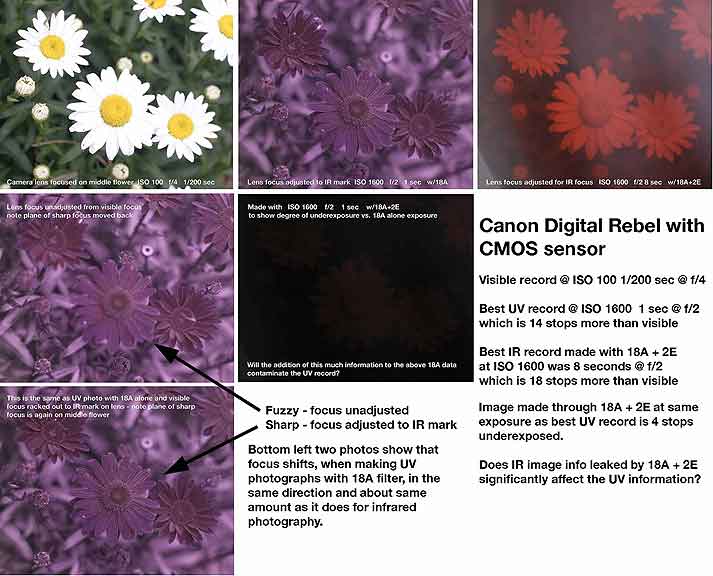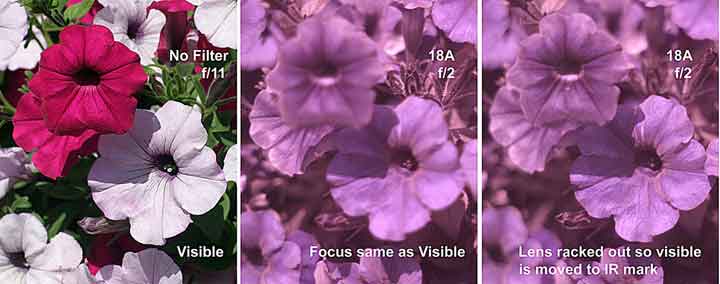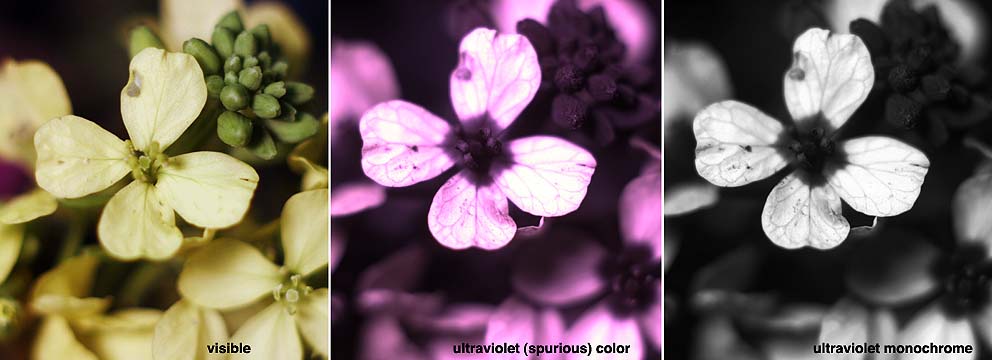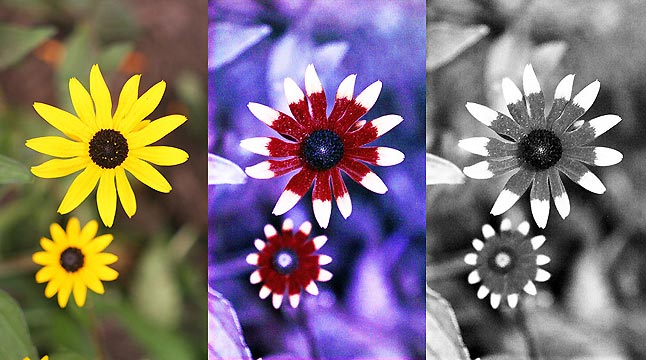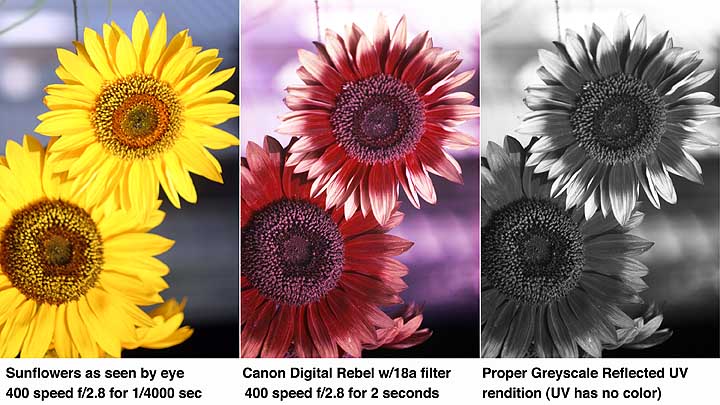|
The Wratten 18A
A problematic filter for reflected ultraviolet photography Andrew Davidhazy School of Photo Arts and Sciences Rochester Institute of Technology With the advent of the possibility of making digital records in the infrared and possibly the ultraviolet regions of the spectrum it is advisable to examine more closely the function of the Wratten 18A filter (or similar equivalents by various manufacturers) that is commonly used for reflected ultraviolet photography. It was, and possibly still is, a common practice to engage in reflected ultraviolet photography by the simple expedient of placing the Wratten 18A over the camera lens and then “firing” away. In the days of film cameras this was an appropriate and most satisfactory approach but in the age of electronic sensors this procedure may yield unexpected and misleading results. Part of the problem lies in the fact that CCD and CMOS sensors, unlike film, have a relatively high sensitivity to infrared forcing manufactures to include infrared absorbing filters ahead of the camera's sensor. It is stated, however, that these sensors do not have a very high sensitivity or response to ultraviolet. Trying to record an image by the residual response of the infrared filtered CCD or CMOS sensor by either infrared or ultraviolet is possible but generally calls for extreme exposure adjustment measures. It is quite likely that when the visually opaque Wratten 18A filter is placed over the camera lens and an exposure made an apparently useable image will be stored in the camera's memory or image storage device. The careful investigator, however, needs to make sure that the image described as one representing the subject features in the ultraviolet is indeed that and not something else. The reason for this concern is that the Wratten 18A not only is a good transmitter of ultraviolet radiation but also has a relatively high transmittance in the near infrared. This can be seen in the transmittance curves shown below. 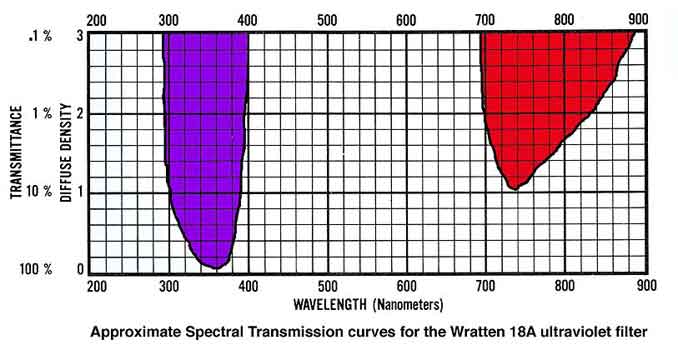
When the 18A filter is used with standard B&W film the
fact that
the 18A “leaks” infrared is of no consequence since the film is
inherently not sensitive in that region of the spectrum. The problem in
the digital era is that even if fitted with an infrared blocking filter
of "hot mirror" the CCD and CMOS devices are sensitive to infrared. Not
a lot but some. So how to make sure, or relatively sure, that a photograph that is desired to be a record made only by its ultraviolet reflectance is indeed only exposed by ultraviolet? There are at least two ways to approach the problem. The first calls for removing the infrared wavelengths transmitted by the 18A from the energy reflected back from the subject or that is falling on the subject. One might think that this can be done by incorporating a very efficient infrared blocking filter, such as Corning 9780 or 9788 material or equivalent, along with the 18A filter. The problem with this is that the 9780 filter absorbs ultraviolet so this is not a good or practical solution. Filters designated “hot mirrors” sometimes also perform the function of removing most infrared from the transmitted radiation but one needs to make sure that they do not transmit the infrared wavelengths that the 18A passes. The function of these filters is to effectively make the chip insensitive to infrared. Making it more like standard B&W film in its response. But the hot mirrors in amateur cameras are not totally infrared opaque and some block UV to some extent also. So, not trusting the degree to which hot mirrors would eliminate the infrared portion of the spectrum transmitted by the 18A filter I took a different approach by trying to determine what the exposure difference would be required to produce a good ultraviolet and a good infrared record. In short, one can easily “see” the effect of the infrared “leak” of the 18A filter by making a record through the 18A filter first then making a second exposure with a Wratten 2E or similar pale yellow ultraviolet blocking filter placed over the 18A. The 2E allows visible light as well as infrared through but does not allow ultraviolet to pass. Since the 18A only allows ultraviolet through, the combination will exclude ultraviolet from the camera's sensor. However, the camera may still record an image. Is that a record of the ultraviolet? Not likely since ultraviolet is blocked by the 2E filter. So it must be infrared. With the lens covered by the 18A/2E combination, if the camera is aimed at a source rich in infrared then nothing should be recorded by the chip in the camera. If an image is recorded it could only have been made by the infrared leaking through the 18A/2E combination. Of course we also need to consider the spectral sensitivity of the CCD sensor. As stated above these are not very sensitive in the UV. Manufacturers must take special pains to make chips that are sensitive to these wavelengths. Most consumer grade cameras have reduced UV sensitivity. However, if one can tolerate the use of large lens apertures and long exposure times there is a glimmer of hope that a rudimentary UV record can be made. This is shown by the example below.  To check on this a set of exposures was made starting with the exposure necessary for a good visible record and then through the Wratten 18A with exposure adjusted "stop-wise" until a useful ultraviolet record was obtained. Under clear skies and sunlight the exposure spread was about 14 stops. Then a Wratten 2E was placed over the 18A. This eliminated the ultraviolet passed by the 18A leaving the infrared that the 18A passed untouched. When an exposure was made using the same settings as for the best UV record the result obtained was very underexposed and dark. Further increases in exposure were made and eventually this resulted in a useable infrared record about 4 to 5 stops beyond that required for the UV exposure. From this a generalized comment can be made about the effect of infrared leakage of the 18A filter and this is that under most conditions the infrared transmitted by the 18A has very little, if any, effect on the ultraviolet record. While at it a check on focus shift when photographing in the ultraviolet was made. This confirmed the fact that unlike what might be expected, the lens needs to be moved further away from the image plane, much like for infrared imaging, in order to bring the UV rays to a sharp focus. The reason for this is that most lenses are designed as achromats and bend the spectral focus such that two visible wavelengths are brought to a common focus. This bending then causes the infrared and the ultraviolet to both come to a sharp focus farther from the lens than visible ones. It is suggested that the infrared focus mark be used as a guide to adjust ultraviolet focus just as one would for infrared use. Below is another sample of the focus adjustment effect (as well as the shift in appearance of the red and white flowers so they appear virtually the same in the ultraviolet while widely different in the visible). Here are some more examples of flowers changing appearance when shown by their ultraviolet reflectance. Note that since ultraviolet is not a "color" as such, ultraviolet (and indeed infrared as well) records should be shown as monochromatic, grayscale, images. False color reproductions included below are due to residual unequal response of the photosites under the Bayer filter. Pretty to look at sometimes but false color nevertheless. So there you have my opinion about
the effect of infrared leakage on a near ultraviolet record made
through
a Watten 18A filter, the focus shift associated with photographing in
the near UV and examples of various flowers showing significant
difference in their appearance when viewed as ultraviolet contrasted to
their visible appearance.
If you have any questions or
want to discuss the matter further feel free to contact me by email at:
andpph@davidhazy.org
Thank you for any constructive
comments you care to make!!
Andrew Davidhazy |
